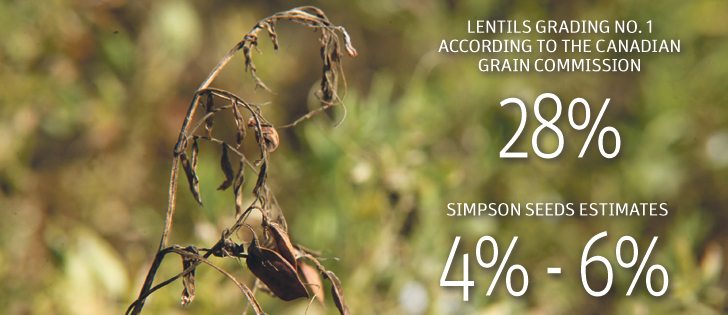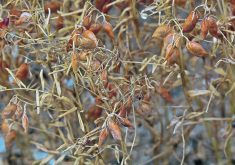A major lentil processor is fed up with what it says are misleading lentil quality reports produced by the Canadian Grain Commission.
“They are nowhere near representative of what is actually going on in the countryside,” said Greg Simpson, president of Simpson Seeds, a processor headquartered in Moose Jaw, Sask.
The commission published a report stating that of the 416 lentil samples it had analyzed as of Oct. 11, 28 percent graded No. 1, 35 percent No. 2, 26 percent extra 3 and 11 percent No. 3.
Simpson said that does not come close to reflecting reality. He estimates four to six percent of the crop will make the top grade based on what he has seen come through the company’s facilities.
Read Also

Critical growing season is ahead for soybeans
What the weather turns out to be in the United States is going to have a significant impact on Canadian producers’ prices
He said the commission’s sample size is too small and because the program is voluntary it is not representative of what’s out in the country.
The report causes him problems when dealing with overseas buyers, who get a false representation of available product.
“They get that report and it basically makes us look foolish as an industry,” said Simpson.
“The grain commission should stop publishing a report that is so inaccurate that it really destroys the credibility of the industry.”
Daryl Beswitherick, program manager of quality assurance standards with the CGC, agreed that it is a small sample size but that doesn’t mean it is inaccurate.
“It generally is a pretty good representation of what’s out there,” he said.
Beswitherick noted that typically the earlier harvested crop is of better quality, so the percent of No. 1 could fall as the harvest proceeds.
He also pointed out that lentils are typically traded as No. 2 or better, so it doesn’t really matter how much of the crop makes the No. 1 grade.
He invited Simpson to contact the commission directly.
“The grain commission is definitely open to having discussions with the industry to ensure that information is accurate,” said Beswitherick. “We would entertain having those discussions directly with anybody who is dissatisfied with any information that’s on our website.”
Simpson said he believes it is time to dismantle the commission.
“We have an agency that is supposed to be helping us that is actually hindering us as an industry,” he said.
“They should just hang up their skates. They’re irrelevant now in terms of what they do.”
For instance, if Simpson has a complaint with an offshore buyer, he uses SGS to resolve the grading dispute rather than the commission.
“Yes, they do provide oversight for the regulation of the Canada Grains Act but who cares?” he said. “They should just bow out gracefully and let the industry run without them.”
Beswitherick said the CGC serves many purposes beyond setting grain trading standards:
- It protects producers by resolving grain grade disputes.
- It helps maintain access to important export markets, such as playing a big role in resolving the recent canola dockage dispute with China.
- It ensures grain shipments are within the allowable pesticide residue limits.
Beswitherick acknowledged that the pulse industry does not use the commission’s grain grading services as much as it once did be-cause it often conducts business using specifications outside of the CGC’s grading specifications.
Simpson said Saskatchewan Agriculture has a better feel for lentil quality because it has boots on the ground in the form of crop reporters.
In its Sept. 12 crop report, Sask-atchewan Agriculture estimated four percent of the crop would be No. 1, 42 percent No. 2, 43 percent extra 3 and No. 3 and 11 percent sample.
“I suspect those lentil grades that we got Sept. 12 will stay pretty true throughout the rest of the harvest here with maybe a few percentage points moving be-tween grades,” said Daphne Cruise, regional crops specialist with the province.
If anything, she thinks the quality will worsen because there was still 28 percent of the lentil crop left in the field on Sept. 12 and that later-harvested crop will be of poorer quality.
“A lot of the colour is going to be washed out of those lentils. We might see some sprouting happen as well,” said Cruise.
Simpson said most of the crop will be at the bottom end of the No. 2 grade or an extra 3.
“Greens have taken it on the chin a lot more because colour is such a big factor,” he said.
The market will command a premium for No. 2 quality or better lentils. Buyers are typically looking for good quality product in the fall.
It may take more time to market the extra 3 and No. 3 lentils, but they will eventually sell.
Simpson said the lentil market has bottomed out and is heading higher as buyers come to grips with Canada’s poor quality crop and an Indian kharif crop, harvested in October or November, that isn’t as good as once believed.
“The worst is behind us in terms of the bear market condition that was existing around harvest time,” Simpson said.


















